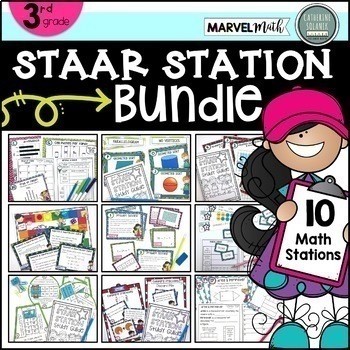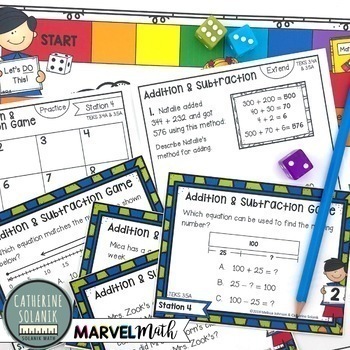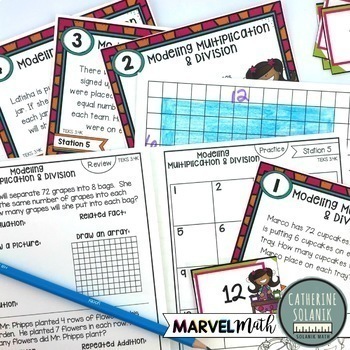3rd Grade Math STAAR Stations Bundle | Fun & Engaging Math Centers
- Zip
What educators are saying
Products in this Bundle (10)
showing 1-5 of 10 products
Bonus
Description
The Big Ideas for 3rd grade in one resource! Looking for FUN and ENGAGING TEKS aligned math stations? This Bundle includes 10 STAAR Math Stations that address all the Readiness Standards TEKS for 3rd grade math and a STAAR Study Guide Booklet. The STAAR Study Guide provides a review of each Readiness Standard, a page for students to record their work at each math center, and an extension page for students to complete after their workstation time. These resources work great as a review of 3rd grade Big Ideas, as a Test-Prep resource, for RTI and Small Group, for Summer School, or as an End of Year culmination activity!
❤️ This resource is a collaborative effort between two deeply passionate Texas math loving teachers with experience in the K through 10th classrooms as teachers, coaches, and math specialists. We are both incredibly proud of this resource we created together!!!
→Catherine Solanik ~ Solanik Math
→Melissa Johnson ~ Marvel Math
STAAR Stations Included in This Bundle
STAAR Station 1 Place Value
STAAR Station 2 Equivalent Fractions
STAAR Station 3 Comparing Fractions
STAAR Station 4 Addition & Subtraction Game
STAAR Station 5 Modeling Multiplication & Division
STAAR Station 6 Problem Solving
STAAR Station 7 Table Puzzles
STAAR Station 8 Geometry Sort
STAAR Station 9 Area & Perimeter
STAAR Station 10 Data True or False?
WHAT'S INCLUDED?
✅ 10 STAAR Math Stations: Each STAAR “fun” Station is unique and targets 1 to 2 TEKS Readiness standards. Some of the activities included are: spinner game, matching, sorting, true or false, making models, puzzles, and a game board that can be used with any set of question cards!
Each station comes with instructions that include “I can” TEKS statements and TEKS are listed on station cards.
✅ STAAR Study Guide Booklet: This STAAR Study Guide student booklet comes with a Review, Practice, Extend, and Notes section. Students record their work in their study guides as they rotate through each station. When completed this study guide serves as a test-prep or study tool!
✅ Teacher Answer Keys: Two answer key formats are provided. A student friendly version is included in each station so students can check their work. A Teacher Edition version of the STAAR Station Study Guide provides answers for all sections.
✅ Station Cover Pages for Easy Organization: Each station comes with a cover page which includes “I can” statements identifying the standards that each activity targets. These covers work great to organize each station.
✅ List of Readiness Standards
✅ Color and Blackline: All stations included in both color and black-white versions.
✅ This is a 241 page resource that comes in a zip file format.
TEKS INCLUDED Readiness Standards:
✓3.2(A) Compose and decompose numbers up to 100,000 as a sum of so many ten thousands,
so many thousands, so many hundreds, so many tens, and so many ones using objects, pictorial models, and numbers, including expanded notation as appropriate.
✓3.2(D) Compare and order whole numbers up to 100,000 and represent comparisons using the symbols
✓3.3(F) Represent equivalent fractions with denominators of 2, 3, 4, 6, and 8 using a variety of objects and pictorial models, including number lines.
✓3.3(H) Compare two fractions having the same numerator or denominator in problems by reasoning about their sizes and justifying the conclusion using symbols, words, objects, and pictorial models.
✓3.4(A) Solve with fluency one-step and two-step problems involving addition and subtraction within 1,000 using strategies based on place value, properties of operations, and the relationship between addition and subtraction.
✓3.5(A) Represent one- and two-step problems involving addition and subtraction of whole numbers to 1,000 using pictorial models, number lines, and equations.
✓3.4(K) Solve one-step and two-step problems involving multiplication and division within 100 using strategies based on objects; pictorial models, including arrays, area models, and equal groups; properties of operations; or recall of facts.
✓3.5(B) Represent and solve one- and two-step multiplication and division problems within 100 using arrays, strip diagrams, and equations.
✓ 3.5(E) Represent real-world relationships using number pairs in a table and verbal descriptions.
✓ 3.6(A) Classify and sort two- and three-dimensional figures, including cones, cylinders, spheres, triangular and rectangular prisms, and cubes, based on attributes using formal geometric language.
✓3.6(C) Determine the area of rectangles with whole number side lengths in problems using multiplication related to the number of rows times the number of unit squares in each row.
✓3.7(B) Determine the perimeter of a polygon or a missing length when given perimeter and remaining side lengths in problems.
✓3.8(A) Summarize a data set with multiple categories using a frequency table, dot plot, pictograph, or bar graph with scaled intervals.
→ Need this resource for another grade? More grade levels in the works as well as other collaborative efforts. Be sure to follow both our stores as different resources will be posted in each store!
❤️ We hope this description helps to clarify! If you have any questions or would like to contact us you can use the “Ask a Question” tab in our stores. You can also reach us through email. We are happy to hear from you!
→Catherine Solanik ~ solanikcurriculum@gmail.com
→Melissa Johnson ~ Marvel Mathmelissa@marvelmath.com
✅ FOLLOW ME for New Products, Sales, and Freebies!
❤️ I hope this description helps to clarify! If you have any questions or would like to contact me feel free to email me at solanikcurriculum@gmail.com
Terms of Use
Copyright © Catherine Solanik, Melissa Johnson. All rights reserved by author. This product is to be used by the original downloader only. Copying for more than one teacher, classroom, department,
school, or school system is prohibited. This product may not be distributed or displayed digitally for public view. Failure to comply is a copyright infringement and a violation of the Digital Millennium Copyright Act (DMCA). Clipart and elements found in this PDF are copyrighted and cannot be extracted and used outside of this file without permission or license. Intended for classroom and personal use only.





